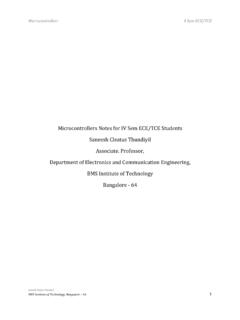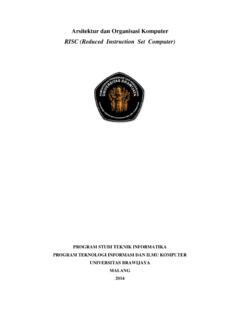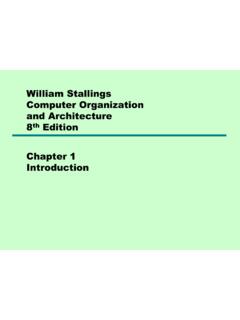Transcription of Microprocessors - Tutorialspoint
1 Microprocessors About the Tutorial A microprocessor is a controlling unit of a micro- computer , fabricated on a small chip capable of performing Arithmetic Logical Unit (ALU) operations and communicating with the other devices connected to it. In this tutorial, we will discuss the architecture, pin diagram and other key concepts of Microprocessors . Audience This tutorial is designed for all those readers pursing either Bachelor's or Master's degree in computer Science. It will help them understand the basic concepts related to Microprocessors . Prerequisites In this tutorial, all the topics have been explained from elementary level. Therefore, a beginner can understand this tutorial very easily.
2 However if you have a prior knowledge of computer architecture in general, then it will be quite easy to grasp the concepts explained here. Disclaimer & Copyright Copyright 2016 by Tutorials Point (I) Pvt. Ltd. All the content and graphics published in this e-book are the property of Tutorials Point (I). Pvt. Ltd. The user of this e-book is prohibited to reuse, retain, copy, distribute or republish any contents or a part of contents of this e-book in any manner without written consent of the publisher. We strive to update the contents of our website and tutorials as timely and as precisely as possible, however, the contents may contain inaccuracies or errors.
3 Tutorials Point (I) Pvt. Ltd. provides no guarantee regarding the accuracy, timeliness or completeness of our website or its contents including this tutorial. If you discover any errors on our website or in this tutorial, please notify us at i Microprocessors Table of Contents About the Tutorial .. i Audience .. i Prerequisites .. i Disclaimer & Copyright .. i Table of Contents .. ii 1. 1. Microprocessor Overview .. 2. How does a Microprocessor Work? .. 2. Features of a Microprocessor .. 3. 2. Microprocessor Classification .. 4. RISC Processor .. 4. CISC Processor .. 6. Special Processors .. 7. 8085 MICROPROCESSOR .. 9. 3. 8085 10. 8085 Microprocessor Functional Units.
4 10. 8085 Architecture .. 12. 4. 8085 Pin Configuration .. 13. 5. 8085 Addressing Modes & Interrupts .. 16. Addressing Modes in 8085 .. 16. Interrupts in 8085 .. 16. 6. 8085 Instruction Sets .. 19. Control instructions .. 19. Branching instructions .. 21. Arithmetic instructions .. 24. Data Transfer instructions .. 26. 8085 Demo Programs .. 29. 8086 MICROPROCESSOR .. 32. 7. 8086 Overview .. 33. Features of 8086 .. 33. Comparison between 8085 &8086 33. Architecture of 34. 8. 8086 Functional 35. EU (Execution Unit) .. 35. BIU (Bus Interface Unit) .. 36. ii Microprocessors 9. 8086 Pin Configuration .. 38. 10. 8086 Instruction Sets .. 43.
5 Data Transfer instructions .. 43. Arithmetic instructions .. 44. Bit Manipulation instructions .. 45. String instructions .. 46. Program Execution Transfer instructions (Branch & Loop instructions ) .. 46. Processor Control instructions .. 47. Iteration Control instructions .. 47. Interrupt instructions .. 48. 11. 8086 Interrupts .. 49. Hardware Interrupts .. 49. Software Interrupts .. 50. 12. 8086 Addressing Modes .. 53. MULTIPROCESSOR CONFIGURATION .. 55. 13. Multiprocessor Configuration 56. Coprocessor Configuration .. 56. Closely Coupled Configuration .. 57. Loosely Coupled Configuration .. 58. 14. 8087 Numeric Data Processor .. 60.
6 8087 Architecture .. 60. 8087 Pin Description .. 61. I/O INTERFACING .. 63. 15. I/O Interfacing Overview .. 64. 16. 8279 Programmable Keyboard .. 66. Operational Modes of 8279 .. 70. 17. 8257 DMA Controller .. 71. How DMA Operations are Performed? .. 71. Features of 8257 .. 71. 8257 Architecture .. 72. 76. 18. Microcontrollers Overview .. 77. Difference between Microprocessor and 77. Types of 77. Applications of Microcontrollers .. 78. iii Microprocessors 19. 8051 79. 20. 8051 Pin Description .. 80. 21. 8051 Input Output 82. Pins Current Limitations .. 83. 22. 8051 Interrupts .. 84. PERIPHERAL DEVICES .. 86. 23. Intel 8255A Programmable Peripheral Interface.
7 87. Ports of 8255A .. 87. Operating Modes .. 87. Features of 8255A .. 88. 8255 .. 88. Architecture .. 88. 24. Intel 8255A Pin Description .. 89. 25. Intel 8253 Programmable Interval Timer .. 91. Difference between 8253 and 8254 .. 91. Features of 8253 / 54 .. 91. 8254 Architecture .. 92. 8254 Pin Description .. 92. 26. Intel 8253/54 Operational Modes .. 95. iv Microprocessors Microprocessor 5. 1. Microprocessor Overview Microprocessors Microprocessor is a controlling unit of a micro- computer , fabricated on a small chip capable of performing ALU (Arithmetic Logical Unit) operations and communicating with the other devices connected to it.
8 Microprocessor consists of an ALU, register array, and a control unit. ALU performs arithmetical and logical operations on the data received from the memory or an input device. Register array consists of registers identified by letters like B, C, D, E, H, L and accumulator. The control unit controls the flow of data and instructions within the computer . Block Diagram of a Basic Microcomputer Microprocessor Input Output Device (ALU +Register array + Device Control unit). Memory How does a Microprocessor Work? The microprocessor follows a sequence: Fetch, Decode, and then Execute. Initially, the instructions are stored in the memory in a sequential order.
9 The microprocessor fetches those instructions from the memory, then decodes it and executes those instructions till STOP instruction is reached. Later, it sends the result in binary to the output port. Between these processes, the register stores the temporarily data and ALU performs the computing functions. List of Terms Used in a Microprocessor Here is a list of some of the frequently used terms in a microprocessor: 6. Microprocessors instruction set : It is the set of instructions that the microprocessor can understand. Bandwidth: It is the number of bits processed in a single instruction. Clock Speed: It determines the number of operations per second the processor can perform.
10 It is expressed in megahertz (MHz) or gigahertz (GHz).It is also known as Clock Rate. Word Length: It depends upon the width of internal data bus, registers, ALU, etc. An 8-bit microprocessor can process 8-bit data at a time. The word length ranges from 4. bits to 64 bits depending upon the type of the microcomputer. Data Types: The microprocessor has multiple data type formats like binary, BCD, ASCII, signed and unsigned numbers. Features of a Microprocessor Here is a list of some of the most prominent features of any microprocessor: Cost-effective: The microprocessor chips are available at low prices and results its low cost. Size: The microprocessor is of small size chip, hence is portable.


















